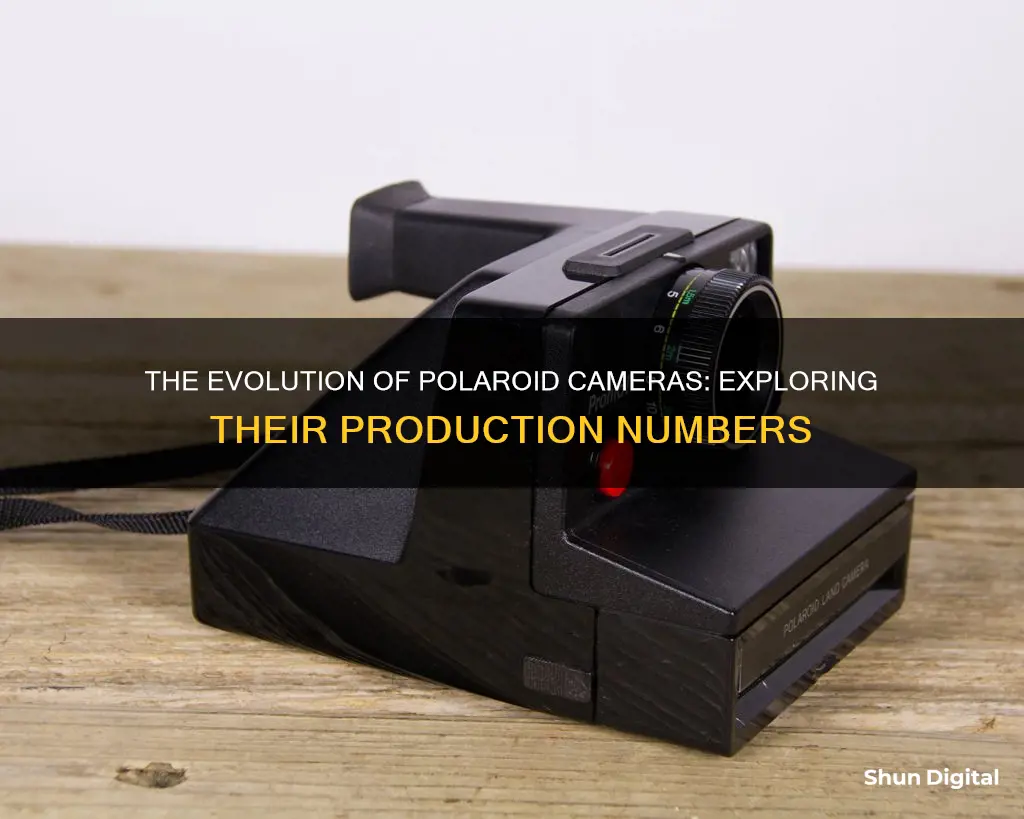
The Polaroid Corporation, founded in 1937 by Edwin H. Land, is best known for its instant film cameras, which reached the market in 1948. The company's original focus was on polarised sunglasses, but it soon pivoted to instant photography. The first Polaroid camera, the Model 95, was released in 1948 and sold out within minutes. Over the years, Polaroid released numerous camera models and by 1977, the company held two-thirds of the instant camera market. However, with the rise of digital photography, Polaroid's sales began to decline, and the company eventually filed for bankruptcy in 2001. While the original Polaroid Corporation no longer exists, the Polaroid brand lives on, and the company's legacy in instant photography remains influential even today.
| Characteristics | Values |
|---|---|
| Year Polaroid Corporation was founded | 1937 |
| Founder of Polaroid Corporation | Edwin H. Land |
| Original name of Polaroid Corporation | Land-Wheelwright Laboratories |
| First instant camera | Model 95, released in 1948 |
| First instant camera price | N/A |
| Total number of Polaroid cameras made | N/A |
What You'll Learn
- The first Polaroid camera, Model 95, was released in 1948
- The Model 95 used sepia-tone film and took 60 seconds to develop
- In 1950, a black-and-white version of the Polaroid was released
- By 1977, Polaroid held two-thirds of the instant camera market
- Polaroid's bankruptcy in 2001 was attributed to the rise of digital photography

The first Polaroid camera, Model 95, was released in 1948
The Model 95 was designed by Dr. Edwin Land, the founder of the Polaroid Corporation. Land was a scientist and inventor, and he is recognised as the father of instant photography. He included all the operations of a darkroom inside the film itself. The Model 95 was the first of Polaroid's instant picture cameras, and over 1.5 million Models 95, 95A and 95B were made. The camera produced prints in about a minute, and when it was first offered for sale at the Jordan Marsh department store in Boston before the 1948 Christmas holiday, all 57 cameras and all of the film were sold on the first day.
The Model 95 was a folding camera for self-processing film packs of 3 1/4 by 4 1/4 inches. It had a lens with a rotating plate with apertures marked 1-8, a T/I shutter, lever focusing, and a folding optical frame finder with a front ball sight on a spring stalk. It was also flash synchronised, with a bayonet fitting. The camera packed the chemistry of a darkroom into a handheld device.
The Model 95 was followed by subsequent models containing various new features. Roll film came in two rolls (positive/developing agent and negative) and was eventually offered in three sizes (40, 30, and 20 series). The first 100 series pack film model was the Model 100, followed by various models in the 100-400 series. The next generation of Polaroid cameras used 100 series "pack film", where the photographer pulled the film out of the camera and then peeled apart the positive from the negative at the end of the developing process.
Charging Lorex Cameras: Quick and Easy Guide
You may want to see also

The Model 95 used sepia-tone film and took 60 seconds to develop
The Polaroid Model 95 was the company's first instant camera, introduced in 1948. It was the first of Polaroid's instant picture cameras, and over 1.5 million Models 95, 95A and 95B were made. The camera was a folding camera for self-processing film packs measuring 3 1/4 by 4 1/4 inches. The Model 95 used an early form of instant roll film that would be pulled from the camera one exposure at a time. The film development process took a little over a minute, which was slow by later instant film standards, but revolutionary when it was first introduced. The Model 95 used sepia-tone film, and the prints took 60 seconds to develop.
The Model 95 was designed by Dr Edwin Land, the founder of the Polaroid Corporation. The camera was the first successful implementation of a self-developing 'instant' film camera. The name 'Polaroid' became synonymous with instant photography in the second half of the 20th century. The Model 95 was a very large camera, weighing almost 2kg. The camera's large size was necessary to house the complex system of rollers required for the instant film to work. The camera used both a positive and negative sheet, with developing chemicals sandwiched between. The negative layer had to be separated and run across the film plane to expose an image.
The Model 95 used Polaroid 40-series film, which was discontinued in 1992. The camera featured a 135mm Polaroid f/11 coated 3-element lens, with a focus range of 4 feet to infinity. The shutter was a Polaroid Rotary Leaf, with speeds of B, 1/8 – 1/60. The camera did not have an exposure meter and did not require batteries. The Model 95 was flash compatible, with an M and X sync via ASA port and a proprietary two-pin connector.
Disabling C-Stick Camera Mode: A Quick Guide
You may want to see also

In 1950, a black-and-white version of the Polaroid was released
Edwin H. Land, the founder of the Polaroid Corporation, developed the first instant camera during World War II. The first Polaroid camera was released in 1948, and in 1950, a black-and-white version of the Polaroid was released. These early Polaroid cameras relied on the photographer to time the development of the film, pull out the print to burst a pod of developing chemicals, and peel away the top film.
The process of taking a photograph with these early Polaroids was as follows: the photographer would use a light meter to take a reading of the light level, then set the exposure setting on the lens. Next, they would focus the lens and frame the shot before taking the picture. After taking the photograph, the photographer would flip a switch and pull a tab at the back of the camera to spread the developing agent onto the negative. Finally, after allowing the picture to develop inside the camera for the required amount of time, the photographer would open a small door at the back of the camera and peel the positive print away from the negative.
The release of the black-and-white Polaroid in 1950 was significant because it marked the beginning of Polaroid's efforts to streamline the instant photography process and reduce the time between taking a photograph and viewing the image. Indeed, as instant camera technology progressed, it became possible for Polaroid prints to develop within a minute in front of the user. This convenience and speed of image development contributed to the popularity of Polaroid cameras, which held two-thirds of the instant camera market by 1977, despite competition from Kodak.
The introduction of black-and-white Polaroids in 1950 was also notable because it demonstrated Polaroid's responsiveness to consumer demand. The company had published a magazine advertisement for their black-and-white film before it was even available, and their employees worked diligently to meet the public's expectations. This proactive approach to product development and marketing helped establish Polaroid as a leader in the instant photography market and fostered a strong relationship with consumers.
Point-and-Shoot Cameras: Can They Shoot RAW?
You may want to see also

By 1977, Polaroid held two-thirds of the instant camera market
The Polaroid Corporation was founded in 1937 by Edwin H. Land, who also invented the first instant camera during World War II as a hobby. After the war, the growth of the American economy allowed new industries to flourish, including instant photography. The first Polaroid camera, the Land Camera, was introduced in 1948.
Polaroid's initial market was in polarised sunglasses, stemming from Land's self-guided research in light polarisation. The company then began employing polarisation in products such as 3D movies and protective goggles for military dogs. During World War II, Polaroid also designed and manufactured products like an infrared night-viewing device for the armed services.
In the 1940s, Polaroid purchased the B B Chemical Company building in Cambridge, Massachusetts, for its headquarters. The company continued to innovate and expand, and by 1972, it had introduced the SX-70, the first instant camera that ejected the print automatically.
Polaroid's success in the instant camera market continued to grow, and by 1977, it held two-thirds of the market. This was despite competition from Kodak, which had announced its own instant film cameras in 1976. The introduction of Kodak's instant cameras led to a lawsuit from Polaroid, which accused Kodak of stealing its patented instant photography process. The lawsuit lasted 10 years, with the court ultimately ruling in Polaroid's favour.
In the same year, Land introduced the Polaroid Instant Home Movie camera, called Polavision. However, this product failed to sell well as it was released when videotape-based systems were gaining popularity. This ultimately led to Land's resignation from the company he founded.
Polaroid's success in the instant camera market was due to its ability to minimise the time between taking a photograph and viewing the image. The company also continuously improved its products, such as introducing black-and-white prints in 1950, peel-apart colour prints in 1963, and non-peel-apart colour prints in 1972.
The global Polaroid market has witnessed significant growth in recent years, fuelled by increasing demand for instant photography and nostalgia-driven consumer preferences. Polaroid has expanded its target demographics beyond photography enthusiasts to include millennials, Gen Z, and travellers seeking experiential photography. The company has also embraced digital technologies, offering hybrid cameras that combine instant printing with digital capabilities.
G-Mod Camera Controls: Assigning Keys for Camera Movement
You may want to see also

Polaroid's bankruptcy in 2001 was attributed to the rise of digital photography
The Polaroid Corporation, founded in 1937, is best known for its instant film and cameras. The company was founded by Edwin H. Land to exploit the use of his Polaroid polarizing polymer. Land and Polaroid created the first instant camera, the Land Camera, in 1948.
The company's peak revenue was $3 billion in 1991. However, Polaroid filed for bankruptcy in 2001, and its brand and assets were sold off. This decline has been attributed to the rise of digital photography and Polaroid's failure to adapt to changing consumer trends.
Polaroid's business model relied heavily on the sale of instant film, with the company creating new cameras to drive film sales. This model worked well for several decades, and Polaroid enjoyed significant success and popularity during this time. However, with the advent of digital photography, the market began to shift away from instant cameras and film. Polaroid failed to recognize this shift and continued to focus on its instant film business, assuming that customer preferences would remain unchanged.
Additionally, Polaroid executives refused to diversify their product offerings. Even with significant investments in R&D for digital imaging, the company remained committed to instant film, believing that hard-copy prints would always be the top trend. This aversion to innovation left Polaroid unprepared for the digital revolution.
By the time Polaroid recognized the need to diversify, it was too late. The company attempted to enter the video cassette, camcorder, and digital camera markets but failed to gain traction against strong competitors. Polaroid's inability to keep up with the innovation in digital photography and its reluctance to adapt to changing market trends ultimately led to its bankruptcy in 2001.
Are Rexing Dash Cams Charging? A Quick Guide to Know
You may want to see also
Frequently asked questions
It is difficult to determine the exact number of Polaroid cameras produced as the company has undergone several changes in ownership and management. However, by 1963, over five million Polaroid instant cameras had been manufactured.
There have been numerous models of Polaroid cameras introduced over the years, with new versions and improvements released periodically. A non-exhaustive list of models includes the Highlander, Land Camera, Speedliner, Swinger, Pronto, and SX-70, among others.
The first Polaroid camera, the Model 95, was released in 1948.
Polaroid cameras used various types of film, including roll film, pack film, and integral film. The company also produced special film for industrial and professional use, such as passport and macro cameras.
The original Polaroid Corporation no longer exists, but the brand has changed hands multiple times, and new Polaroid-branded products continue to be released by different companies. While Polaroid-branded digital cameras and other electronics are still available, the production of instant film and cameras has been discontinued and revived multiple times.







